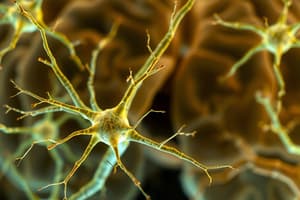Podcast
Questions and Answers
What term describes the brain's ability to reorganize itself after damage or experience?
What term describes the brain's ability to reorganize itself after damage or experience?
- Glial Cells
- Plasticity (correct)
- Threshold
- Neurotransmitter
Which part of a neuron is responsible for integrating messages and conducting them toward the cell body?
Which part of a neuron is responsible for integrating messages and conducting them toward the cell body?
- Dendrites (correct)
- Cell Body
- Axon
- Synapse
What happens during the refractory period of a neuron?
What happens during the refractory period of a neuron?
- The neuron can fire multiple action potentials
- The neuron sends neurotransmitters to other neurons
- The neuron is preparing to deliver a new message
- The neuron is in a resting state and cannot fire (correct)
Which part of the nervous system connects the central nervous system to the rest of the body?
Which part of the nervous system connects the central nervous system to the rest of the body?
What is the primary function of glial cells within the nervous system?
What is the primary function of glial cells within the nervous system?
What defines the all-or-none law in the context of neuron firing?
What defines the all-or-none law in the context of neuron firing?
Where is the limbic system primarily located in the brain?
Where is the limbic system primarily located in the brain?
Which of the following accurately describes the function of neurotransmitters?
Which of the following accurately describes the function of neurotransmitters?
Flashcards
Plasticity
Plasticity
The brain's ability to change by reorganizing after damage or building new pathways based on experience.
Neuron
Neuron
A nerve cell; the basic building block of the nervous system.
Synapses
Synapses
The junction between the axon tip of a sending neuron and the dendrite of a receiving neuron.
Neurotransmitter
Neurotransmitter
Signup and view all the flashcards
All-or-None Law
All-or-None Law
Signup and view all the flashcards
Refractory Period
Refractory Period
Signup and view all the flashcards
Central Nervous System
Central Nervous System
Signup and view all the flashcards
Hormones
Hormones
Signup and view all the flashcards
Study Notes
Plasticity
- The brain's ability to change, especially during childhood, by reorganizing after damage or by building new pathways based on experience.
Neuron
- A nerve cell; the basic building block of the nervous system.
Cell Body
- The part of a neuron that contains the nucleus; the cell's life-support center.
Dendrites
- Neuron extensions that receive and integrate messages, conducting them toward the cell body.
Axon
- The neuron extension that sends messages to other neurons, muscles, or glands.
Action Potentials
- A nerve impulse; a brief electrical charge that travels down an axon.
Glial Cells
- Cells in the nervous system that support, nourish, and protect neurons; also play a role in learning, thinking, and memory.
Synapses
- The junction between the axon tip of a sending neuron and the dendrite or cell body of a receiving neuron. The tiny gap at this junction is called the synaptic gap or synaptic cleft.
Neurotransmitters
- Neuron-produced chemicals that cross the synaptic gap to carry messages to other neurons, muscles, or glands.
All-or-None Law
- A neuron's reaction of either firing (with a full-strength response) or not firing.
Threshold
- The level of stimulation required to trigger a neural impulse.
Refractory Period
- A brief resting pause that occurs after a neuron fires; subsequent action potentials cannot occur until the axon returns to its resting state.
Nervous System
- The body's speedy, electrochemical communication network, consisting of all the nerve cells of the central and peripheral nervous systems.
Peripheral Nervous System
- The sensory and motor neurons connecting the central nervous system to the rest of the body.
Central Nervous System
- The brain and spinal cord.
Endocrine System
- The body's "slow" chemical communication system, a set of glands that secrete hormones into the bloodstream.
Hormones
- Chemical messengers manufactured by endocrine glands, traveling through the bloodstream to affect other tissues.
Limbic System
- Neural system (including the amygdala, hypothalamus, and hippocampus) located below the cerebral hemispheres; associated with emotions and drives.
Frontal Lobes
- Portion of the cerebral cortex lying just behind the forehead; involved in speaking, muscle movements, planning, and judgments.
Parietal Lobes
- Portion of the cerebral cortex lying at the top of the head and toward the rear; receives sensory input for touch and body position.
Occipital Lobes
- Portion of the cerebral cortex lying at the back of the head; includes areas that receive information from the visual fields.
Temporal Lobes
- Portion of the cerebral cortex lying roughly above the ears; includes areas that receive information from the ears.
Motor Cortex
- Cerebral cortex area at the rear of the frontal lobes; controls voluntary movements.
Somatosensory Cortex
- Cerebral cortex area at the front of the parietal lobes; registers and processes body touch and movement sensations.
Association Areas
- Cerebral cortex areas involved primarily in higher mental functions, such as learning, remembering, thinking, and speaking.
Corpus Collosum
- A large band of neural fibers connecting the two brain hemispheres and carrying messages between them.
Neurogenesis
- The formation of new neurons.
Consciousness
- Our subjective awareness of ourselves and our environment.
Selective Attention
- Focusing conscious awareness on a particular stimulus.
Inattentional/Change Blindness
- Failing to notice changes in the environment; a form of inattentional blindness.
Studying That Suits You
Use AI to generate personalized quizzes and flashcards to suit your learning preferences.



